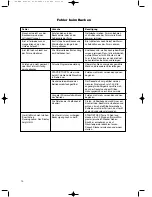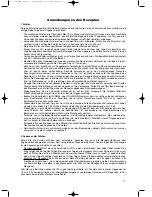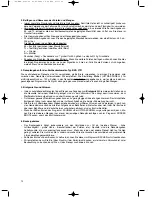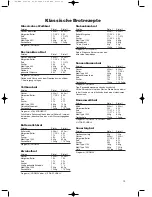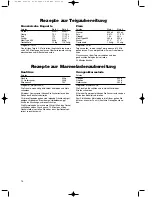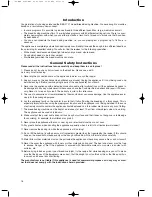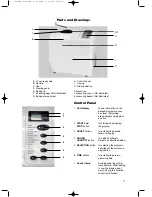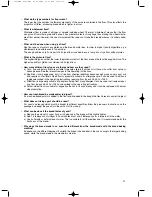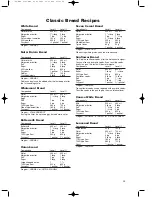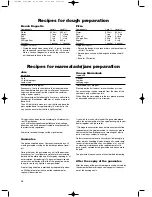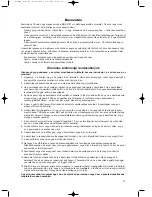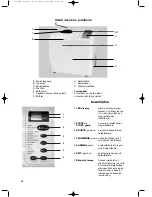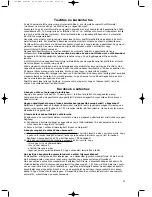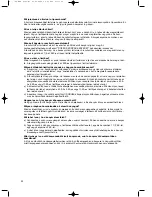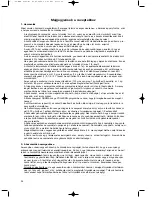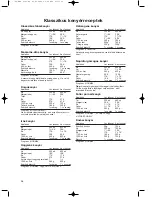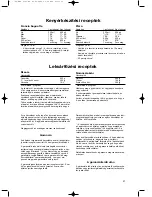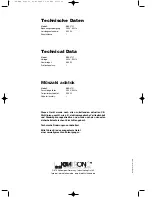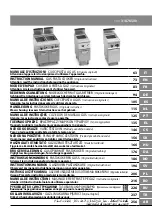
23
Remarks on the Recipes
1. Ingredients
Since each ingredient plays a specific role for the successful baking of the bread, the measuring is just as impor-
tant as the order in which the ingredients are added.
•
The most important ingredients like the liquid, flour, salt, sugar and yeast (either dry or fresh yeast can be
used) affect the successful outcome of the preparation of the dough and the bread. Always use the right quan-
tities in the right proportion.
•
Use lukewarm ingredients if the dough needs to be prepared immediately. If you wish to set the program
phase timing function, it is advisable to use cold ingredients to avoid that the yeast starts to rise too early.
•
Margarine, butter and milk affect the flavor of the bread.
•
Sugar can be reduced by 20% to make the crust lighter and thinner without affecting the successful outcome
of the baking. If you prefer a softer and lighter crust replace the sugar with honey.
•
Gluten which is produced in the flour during the kneading provides for the structure of the bread. The ideal
flour mixture is composed of 40% wholemeal flour and 60% of white flour.
•
If you wish to add cereals grains, leave them to soak overnight. Reduce the quantity of flour and the liquid (up
to 1/5 less).
•
Leaven is indispensable with rye flour. It contains milk and acetobacteria that make the bread lighter and fer-
ment thoroughly. You can make your own leaven but it takes time. For this reason concentrated leaven pow-
der is used in the recipes below. The powder is sold in 15g packets (for 1 kg of flour). Follow the instructions
given in the recipes (1/2, 3/4 or 1 packet). If less leaven that requested is used the bread will crumble.
•
If leaven powders with a different concentration (100 g packet for 1 kg of flour) are used, the quantity of flour
must be reduced by 80 kg for a 1 kg of flour.
•
Liquid leaven sold in bags is also available and it is suitable for use. Follow the doses specified on the pack-
age. Fill the measuring beaker with the liquid leaven and top it up with the other liquid ingredients in the right
doses as specified in the recipe.
•
Wheat leaven which often comes dry improves the workability of the dough, the freshness and the taste. It is
milder that rye leaven.
•
Use either the NORMAL or VOLLKORN program when baking leavened bread. Baking ferment can used to
replace the leaven. The only difference is in the taste. It is fit to be used in the bread baking machine.
•
Wheat bran can be added to the dough if you would like to have loose bread which is particularly high in fibres.
Use one tablespoon for 500 g of flour and increase the quantity of liquid by 1/2 tablespoon.
•
Wheat gluten is a natural additive obtained from wheat proteins. It makes the bread lighter and more volumi-
nous. The bread falls in more rarely and it is more easily digestible. The effect can be easily appreciated when
baking wholemeal and other bakery products made of home-milled flour.
•
Black malt, which is included in some recipes, is a dark, roasted barley malt.
It is used to obtain a darker bread crust and soft part (e.g. brown bread). Rye malt is also suitable but it is not
as dark. You can find this malt in whole food shops.
•
Bread spice can be added to all of our mixed breads. The quantity depends on your taste and the informati-
on provided by the manufacturer.
•
Pure lecithin powder is a natural emulsifier that improves the volume of the bread, makes the soft part softer
and lighter and keeps it fresh longer.
2. Adapting the doses
If the doses need to be increased or reduced, make sure that the proportions of the original recipe are maintai-
ned. To obtain a perfect result, the basic rules below for the adapting of the ingredient doses must be following:
•
Liquids/flour: the dough ought to be soft (not too soft) and easy to knead without becoming stringy. A ball can
be obtained by kneading it lightly. This is not the case with heavy doughs like rye wholemeal or cereal bread.
Check the dough five minutes after the first kneading. If it is too moist, add some flour until the dough has rea-
ched the right consistency. If the dough is too dry add a spoonful of water at a time during the kneading.
•
Replacing liquids: When using ingredients containing liquids in a recipe (e.g. curd cheese, yogurt, etc.), the
required amount of liquid must be reduced. When using eggs beat them in the measuring beaker and fill it
with the other required liquid up to the envisaged amount.
If you are living in a place located at a high altitude (more than 750 m) the dough rises faster. The yeast can be
reduced in these cases by 1/4 to 1/2 of a teaspoon to proportionally reduce its rising. The same is true of places
with particularly soft water.
4....-05-BBA 2721-GB1 06.03.2002 11:59 Uhr Seite 23


